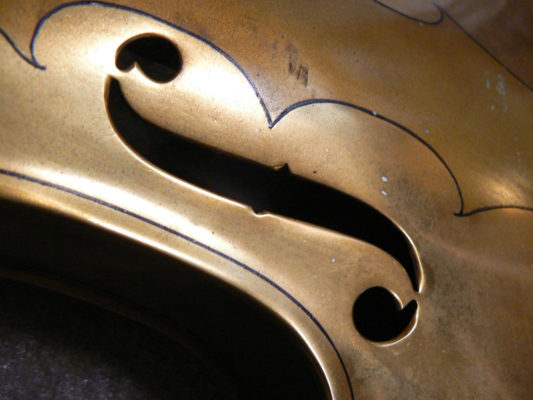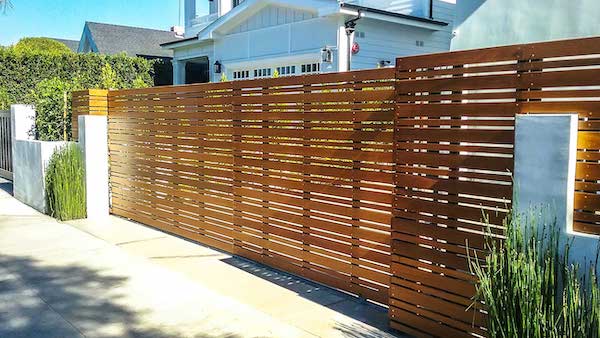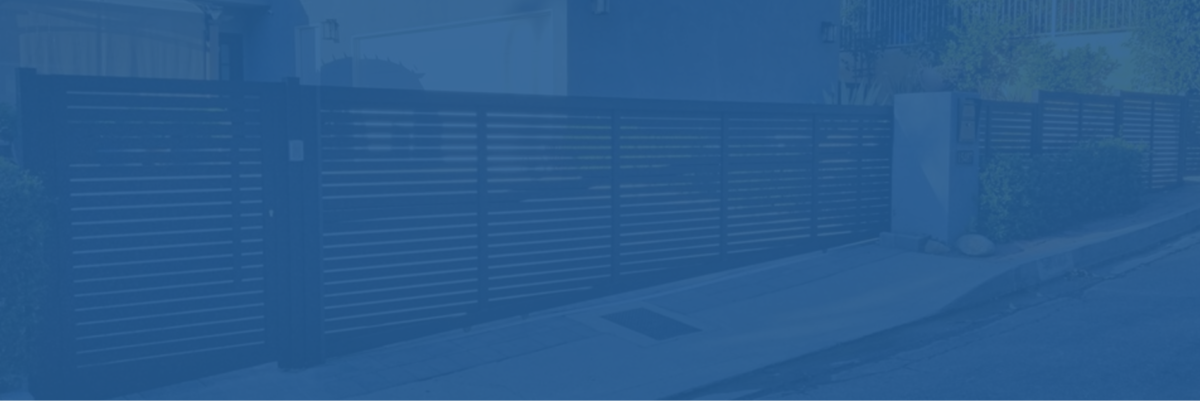Comparing Materials, Education
Comparing Aluminum Fence to Wood Fence, Which is the Winner?
Want some help comparing wood and aluminum fences? In this article, we’ll focus on homes, rather than for rural or commercial uses. There are different criteria for farms and industries that won’t apply to residential.
(note: for easier reading, I will often use the word “fencing” as an embracing term to mean “gates and fences”)
Full disclosure:

I am an “aluminum guy.” Not a “wood guy.” And not a guy who doesn’t care which type of gate or fence you eventually get (I care!). But I’m very much pro-aluminum and I’ll explain why.
But by the time I arrived at aluminum as my “material of preference,” I was very experienced with all the classic fence and gate building materials.
So don’t go away! I’m not here to push you into getting aluminum. I’m here to tell you “the whole truth, and nothing but the truth.”
With fences and gates, I used to be a wood guy. And I used to be an iron guy. And I used to be a stainless steel guy. I’ve made gates and fences from plenty of other materials. I mean, I’m based in Hollywood, and this is where people specialize in making dreams a reality!
So, I’ve “been there and done that” a lot with iron and with wood. You’ll see mountains of evidence of the quality of our work in our wood gallery and our iron gallery, and if you visit our reviews, there’s a lot of those 5-star ones that validate our work in wood and iron.
So, what I want to get across here is, I know the whole subject of fencing and gates very well, and I know all the materials that we can use in their construction, that are at all practical. These materials are, primarily, wood, iron (steel, but usually called ‘iron’ in our industry), stainless steel, vinyl, and aluminum.
I know the pros and cons of these materials, and I can speak about them objectively, and that’s what I will do here: I will do my best to set aside my enthusiasm for aluminum, as I talk about what’s the best in these other materials.

For this article, we will focus on wood and how that compares with aluminum. I’ll deal with the other materials in other articles.
When we talk about fences and gates made from any material, there are a few questions that are always top of mind in conversations about the choice of materials:
- Comparing Wood and Aluminum Fences, Which is More Expensive?
- Comparing Wood and Aluminum Fences, Maintenance-Wise, Which is Better?
- Comparing Wood and Aluminum Fences: Ease of Installation
- Comparing Wood and Aluminum Fences: Privacy
- Comparing Wood and Aluminum Fences: Looks and Style Options
Consider all the pros and cons associated with all of your material options. Fully inform yourself and you will be confident in your decision.
1. Comparing Wood and Aluminum Fences, Which is More Expensive?
Wood Fencing:

It depends on the wood that is chosen. With the most common and inexpensive woods used in fencing, you might spend a little less money initially, when compared to the lower-priced aluminum. But not much less! And, with these competitively priced, lower-cost woods, you will need to put in more time and money over the years to keep them maintained. With the lower cost woods, eventually, you are going to need to replace them no matter what you do. The question isn’t whether you will have to replace them or not, the question is, when?
Note, a basic rule of wood fencing is that all wood fencing requires at least some ongoing maintenance. And the less expensive wood requires more maintenance, more often.
The best wood fencing materials don’t require much maintenance at all, beyond occasional oiling. These woods are also called “ironwoods” and they are generally from South or Central America or Indonesia. These are extremely dense woods and are very long-lasting and very good at weather resistance. We have seen warranties for these for as long at 15 years. One caution with these is there is an environmental impact to the cultivation of many of these woods. Be sure to research the species of wood and the manufacturer of fences made from these exotic woods to make sure you are not harming the planet.
If you have an extensive project, the initial cost of your project for materials alone will be significant. No matter the species of wood you choose, eventually you will need to replace it.
With the most durable of fence woods, the ironwoods, you will pay a premium at the time of purchase and will need to replace the fence within 25 years, even if you take excellent care of it.
You also need to take into consideration staining and finishing, both initially, and at different times (depending primarily on the species of wood and climate) throughout the lifetime of the fencing.
Aluminum Fencing:
Aluminum is less expensive than many types of wood, though not all. To be fully accurate, you will need to compare against the specific kinds of wood (as an example, cedar versus redwood fencing).
The woods that come closest to aluminum in terms of durability and being maintenance-free are higher in price than aluminum, but still don’t come close to their durability or lack-of-maintenance requirements. (The most dramatic price differences are in the installation and maintenance, which we’ll discuss later in this article.)
Which is the Winner?
Regarding initial cost of materials, aluminum fencing and wood fencing are about equal on average. But the woods that come closest to aluminum in quality are higher in price, yet they don’t match aluminum standards.
Note that prices vary for nearly all wood species, and they are going up. The hardest and most durable of the woods used in fences are from tropical lands, and they also are going up in price every year.
Because of the ongoing recycling of aluminum, and better, more efficient technology, the actual cost of manufacturing aluminum products is going down! Aluminum products are much less expensive than they were even 15 years ago!
2. Comparing Wood and Aluminum Fences, Maintenance-Wise, Which is Better?
Wood Fencing:
 Every species of wood fencing requires maintenance. The only variation is how much, how often. Woods that compete in price to aluminum will require minimally yearly maintenance, perhaps more.
Every species of wood fencing requires maintenance. The only variation is how much, how often. Woods that compete in price to aluminum will require minimally yearly maintenance, perhaps more.
Wood, prior to being cut for lumber, survived because of being constantly replenished with water and minerals by the surrounding environment. Wood, when cut down and milled into slats and posts, and then stained and sealed, still wants to breathe and drink. Through the pores of the wood, it takes in air, humidity, and rain, and it expels these when heated by the sun.
Many aspects of the “living wood” of trees still continue in wood that have been cut and milled for fences and gates. Fencing wood still reaches out for air and for water. It dries out and shrinks in the heat, and it tries to quench its thirst during the rain or when the sprinklers are on! This causes the wood to shrink and expand, to bend and to warp. Being organic, it can rot. Sealers, paints and stains will protect for some time, but the climate is not friendly to these either. There are also insects who look to wood fencing for home as well (a different meaning for a “residential fence”!) and many of these same insects use them for a food source. This is especially true in warm or moist climates.
So, the maintenance for wood fencing changes depending on the wood species and climate conditions. No matter the species or the environment, there will always be a need for refinishing, the only variables are how often and how much.
The maintenance actions required to keep wood fencing and gates sound include sanding, re-staining, and refinishing or repainting. Often there are slats or pickets that you need to replace. Often fabricators brace these sorts of gates and fences with iron accessories that you also need to maintain.
Aluminum Fencing:
Aluminum is highly durable. Bugs and mold want nothing to do with it! The smartest finish for aluminum fencing is powder-coating, where an electrolytic process bonds a powdered color to the metal. Fence manufacturers then bake the project in an oven, resulting in a durable protective finish. Powder-coated aluminum keeps its color fast, far longer than wood holds paint, stain, or sealant.
Absent vandalism or intended abuse, your aluminum fence will last much longer than any wood fencing, even for generations.
Quality aluminum fencing, properly installed, should last a lifetime!
Regarding maintenance, which is the winner?
Even the most durable wood fencing does not match up to Aluminum’s low-maintenance characteristics.
3. Comparing Wood and Aluminum Fences: Ease of Installation
Wood Fencing:
Custom or “off the rack”? There are varieties of wood fencing (such as white picket fencing) that you can buy by the panel. Someone with experience and know-how can install these quickly. But if you want a custom job, you will probably need to fabricate it in place.
For nearly all styles of fences and gates (other than the lowest profile white picket fencing), wood fencing is very heavy when compared to aluminum, and takes time to install, and a lot of strength by the installation team. This means more man-hours, and a greater cost for the consumer.
Aluminum Fencing:
 Aluminum is far lighter and has a much better strength-to-weight ratio than wood. Aluminum is generally installed in uniform panels, and this also makes for greater ease and faster installs.
Aluminum is far lighter and has a much better strength-to-weight ratio than wood. Aluminum is generally installed in uniform panels, and this also makes for greater ease and faster installs.
Aluminum gets installed more quickly, with smaller teams, with less opportunity for injury.
Which is the winner?
These factors make aluminum the clear winner.
4. Comparing Wood and Aluminum Fences: Privacy
Wood Fencing:

Wood is wonderfully adaptable for all purposes, including privacy. Practically, you can create wood fences and gates in ways so they can provide very thorough privacy. You can totally obstruct views from passersby easily with any wood. At least, if you work to maintain it.
As discussed earlier, heat and a dry atmosphere cause a general contraction in wood, and cooler temperatures or wetter causes wood to “drink” in the moisture and expand. This contraction and expansion, if not contested with maintenance, will eventually cause gaps between the slats and pickets, lessening privacy.
Aluminum Fencing:
Historically, aluminum’s designs have emulated the ubiquitous “wrought iron” look pictured here. But, “that’s history!” Today, there are a far greater array of styles, including many that match and surpass wood’s capacity for privacy.
Further, aluminum won’t expand or contract because of climate to any measurable amount at all. If you designed your fence and gate for privacy, you’ll have that privacy as long as you own them.
Which is the winner?
It comes, almost, to a draw. Both wood and aluminum fencing can provide excellent privacy. But the wood fencing’s capability to provide ongoing privacy will eventually diminish.
5. Comparing Wood and Aluminum Fences: Looks and Style Options
Wood Fencing:
Wood looks wonderful at the time that the installation is fresh. But there will be deterioration soon. You will see deterioration no matter what you do. For some rural properties, this can have a nice, rustic look. It’s imaginable that this worn appearance might even look nice against some city or suburban homes. But that will not be often.
When wood looks worn, it is because of deterioration. A deterioration in the appearance of wood means that there has been a deterioration in the wood itself.
Please visit our wood gallery to see some fine and diverse styles of wood fencing and gates. But please realize that keeping these installations beautiful requires ongoing attention.
Aluminum Fencing:
Until just a few years ago, nearly all aluminum gates and fencing looked the same. And it all looked very traditional. The styles of aluminum fencing were all slight variations of what you see pictured here. While still keeping in line with this basic design, there has been a wide variety of subtle variations. (I’ll post a few variations so you can get the idea.)
Many call this the “wrought iron look” as these all copy the general design of the first iron fences that protected churches and estates in the nineteenth and eighteenth-century western Europe.
This general style is still the most typical for aluminum fence, and it is a perfect boundary-setter and beautifully complements many properties.
Breaking Away from Tradition
But this style is not for everyone! Recent technology has enabled us to create brand new styles of fencing and gates. We can now provide unique styles in traditional and contemporary styles.
Perhaps the most interesting examples of this newer aluminum technology are the Aluminum and Glass applications. Before aluminum, glass gates and fencing were very popular, but also a headache. When fence contractors use steel in building glass gates and fences, there are always expensive maintenance problems, as there are so many places for water to get past the paint and to the metal, rusting it.
But that’s not the case with aluminum. Aluminum and Glass gates and fencing don’t rust, and so they are no longer a headache. They are a joy for their owners, and a delight for their guests.
For people who have outdoor privacy high on their list, the traditional “wrought iron look” will not work. If you want privacy, fabricators can also produce aluminum fencing can also with a solid profile, or with, as you see here, a hybrid between solid panels and narrow slats with gaps.
An Alternative: Aluminum Gates that Look Like Wood!
 There are also manufacturers (such as Mulholland) who produce a finish on aluminum from photographic images of various wood species. Now you can have that wonderful wood appearance and atmosphere, but not have the worry of wood’s upkeep.
There are also manufacturers (such as Mulholland) who produce a finish on aluminum from photographic images of various wood species. Now you can have that wonderful wood appearance and atmosphere, but not have the worry of wood’s upkeep.
We accomplish this through a chemical reaction that involves a variety of specially developed inks and a polyurethane or polyester powder coating. Using a technology known as sublimation, with heat and pressure, photographic images of wood grain transfer directly into the powder coating covering the aluminum profile.
Here is where you can view other examples of the “Woodlike” line of fences and gates.
Aluminum is the Winner Again! With sublimation technology, you can now get fences and gates that look just like wood, but don’t have any of the hassle. Other outstanding technical advances in aluminum now allow us to make pickets or slats of any dimension. Although the traditional “wrought iron look” aluminum fence and gate remains with us, and will always be popular, there are now hundreds of new options that allow for a wonderful variety of style choices. You can see examples of these, here, here, and here!
Is Aluminum Fencing Looking Like the Option for You?
As I mentioned, I have a lot of experience with wood gates and fencing. I don’t want to leave you with a sour note on wood. The appearance of a well-crafted wood gate and fence can take your breath away. Yes, the sublimation process can get a very close look, but not fully, and get up close, you will see the difference.
The main difference will be the touch; the texture, the feel of the sun radiating off of it. Those subtleties cannot be emulated in aluminum.
If you are certain that you can find the time, or regularly hire someone to maintain it for as long as you own it, that little bit “extra” that you get from the completely natural look of wood, could make that the better choice.
How does this sound to you? For you, which is the better fit? Please continue to research through our site to discover more answers, or call us to ask questions. We’re happy to share our knowledge of wood and aluminum, or anything else in the world of fences, gates, and railing.
5. Comparing Wood and Aluminum Fences: Looks and Style Options
Wood Fencing:
Wood looks wonderful at the time that the installation is fresh. But there will be deterioration soon. You will see deterioration no matter what you do. For some rural properties, this can have a nice, rustic look. It’s imaginable that this worn appearance might even look nice against some city or suburban homes. But that will not be often.
When wood looks worn, it is because of deterioration. A deterioration in the appearance of wood means that there has been a deterioration in the wood itself.
Please visit our wood gallery to see some fine and diverse styles of wood fencing and gates. But please realize that keeping these installations beautiful requires ongoing attention.
Aluminum Fencing:
Until just a few years ago, nearly all aluminum gates and fencing looked the same. And it all looked very traditional. The styles of aluminum fencing were all slight variations of what you see pictured here. While still keeping in line with this basic design, there has been a wide variety of subtle variations. (I’ll post a few variations so you can get the idea.)
Many call this the “wrought iron look” as these all copy the general design of the first iron fences that protected churches and estates in the nineteenth and eighteenth-century western Europe.
This general style is still the most typical for aluminum fence, and it is a perfect boundary-setter and beautifully complements many properties.
Breaking Away from Tradition
But this style is not for everyone! Recent technology has enabled us to create brand new styles of fencing and gates. We can now provide unique styles in traditional and contemporary styles.
Perhaps the most interesting examples of this newer aluminum technology are the Aluminum and Glass applications. Before aluminum, glass gates and fencing were very popular, but also a headache. When fence contractors use steel in building glass gates and fences, there are always expensive maintenance problems, as there are so many places for water to get past the paint and to the metal, rusting it.
But that’s not the case with aluminum. Aluminum and Glass gates and fencing don’t rust, and so they are no longer a headache. They are a joy for their owners, and a delight for their guests.
For people who have outdoor privacy high on their list, the traditional “wrought iron look” will not work. If you want privacy, fabricators can also produce aluminum fencing can also with a solid profile, or with, as you see here, a hybrid between solid panels and narrow slats with gaps.
An Alternative: Aluminum Gates that Look Like Wood!
 There are also manufacturers (such as Mulholland) who produce a finish on aluminum from photographic images of various wood species. Now you can have that wonderful wood appearance and atmosphere, but not have the worry of wood’s upkeep.
There are also manufacturers (such as Mulholland) who produce a finish on aluminum from photographic images of various wood species. Now you can have that wonderful wood appearance and atmosphere, but not have the worry of wood’s upkeep.
We accomplish this through a chemical reaction that involves a variety of specially developed inks and a polyurethane or polyester powder coating. Using a technology known as sublimation, with heat and pressure, photographic images of wood grain transfer directly into the powder coating covering the aluminum profile.
Here is where you can view other examples of the “Woodlike” line of fences and gates.
Aluminum is the Winner Again! With sublimation technology, you can now get fences and gates that look just like wood, but don’t have any of the hassle. Other outstanding technical advances in aluminum now allow us to make pickets or slats of any dimension. Although the traditional “wrought iron look” aluminum fence and gate remains with us, and will always be popular, there are now hundreds of new options that allow for a wonderful variety of style choices. You can see examples of these, here, here, and here!
Is Aluminum Fencing Looking Like the Option for You?
As I mentioned, I have a lot of experience with wood gates and fencing. I don’t want to leave you with a sour note on wood. The appearance of a well-crafted wood gate and fence can take your breath away. Yes, the sublimation process can get a very close look, but not fully, and get up close, you will see the difference.
The main difference will be the touch; the texture, the feel of the sun radiating off of it. Those subtleties cannot be emulated in aluminum.
If you are certain that you can find the time, or regularly hire someone to maintain it for as long as you own it, that little bit “extra” that you get from the completely natural look of wood, could make that the better choice.
How does this sound to you? For you, which is the better fit? Please continue to research through our site to discover more answers, or call us to ask questions. We’re happy to share our knowledge of wood and aluminum, or anything else in the world of fences, gates, and railing.
GET IN TOUCH WITH US TODAY
If you have a project in mind, would like to see our prices, or simply want to check out our inventory in person; good news. We have factory tours and a showroom to help you plan out your current or future project. Call us up and talk to any of our friendly staff and ask us about our current schedule, or to explore ways we may be able to help you with your goals. If you’d like to see our latest projects, explore our inspiration gallery or follow us on Instagram, where we ongoingly post our latest completed projects.
Click the live chat at the bottom of the browser window and connect instantly with our team of experts.

Dan’s very enthusiastic about our products and is a true ambassador for our styles and quality.











